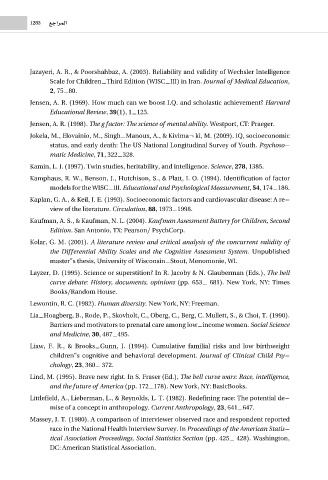Page 1284 - theCambridgehandbookofintelligence1
P. 1284
1283 ™LGôªdG
Jazayeri, A. R., & Poorshahbaz, A. (2003). Reliability and validity of Wechsler Intelligence
Scale for Children-Third Edition (WISC-III) in Iran. Journal of Medical Education,
2, 75-80.
Jensen, A. R. (1969). How much can we boost I.Q. and scholastic achievement? Harvard
Educational Review, 39(1), 1-123.
Jensen, A. R. (1998). The g factor: The science of mental ability. Westport, CT: Praeger.
Jokela, M., Elovainio, M., Singh-Manoux, A., & Kivima¬ ki, M. (2009). IQ, socioeconomic
status, and early death: The US National Longitudinal Survey of Youth. Psychoso-
matic Medicine, 71, 322-328.
Kamin, L. J. (1997). Twin studies, heritability, and intelligence. Science, 278, 1385.
Kamphaus, R. W., Benson, J., Hutchison, S., & Platt, I. O. (1994). Identification of factor
models for the WISC-III. Educational and Psychological Measurement, 54, 174-186.
Kaplan, G. A., & Keil, J. E. (1993). Socioeconomic factors and cardiovascular disease: A re-
view of the literature. Circulation, 88, 1973-1998.
Kaufman, A. S., & Kaufman, N. L. (2004). Kaufman Assessment Battery for Children, Second
Edition. San Antonio, TX: Pearson/ PsychCorp.
Kolar, G. M. (2001). A literature review and critical analysis of the concurrent validity of
the Differential Ability Scales and the Cognitive Assessment System. Unpublished
master s thesis, University of Wisconsin-Stout, Menomonie, WI.
Layzer, D. (1995). Science or superstition? In R. Jacoby & N. Glauberman (Eds.), The bell
curve debate: History, documents, opinions (pp. 653- 681). New York, NY: Times
Books/Random House.
Lewontin, R. C. (1982). Human diversity. New York, NY: Freeman.
Lia-Hoagberg, B., Rode, P., Skovholt, C., Oberg, C., Berg, C. Mullett, S., & Choi, T. (1990).
Barriers and motivators to prenatal care among low-income women. Social Science
and Medicine, 30, 487-495.
Liaw, F. R., & Brooks-Gunn, J. (1994). Cumulative familial risks and low birthweight
children s cognitive and behavioral development. Journal of Clinical Child Psy-
chology, 23, 360- 372.
Lind, M. (1995). Brave new right. In S. Fraser (Ed.), The bell curve wars: Race, intelligence,
and the future of America (pp. 172-178). New York, NY: BasicBooks.
Littlefield, A., Lieberman, L., & Reynolds, L. T. (1982). Redefining race: The potential de-
mise of a concept in anthropology. Current Anthropology, 23, 641-647.
Massey, J. T. (1980). A comparison of interviewer observed race and respondent reported
race in the National Health Interview Survey. In Proceedings of the American Statis-
tical Association Proceedings, Social Statistics Section (pp. 425- 428). Washington,
DC: American Statistical Association.

